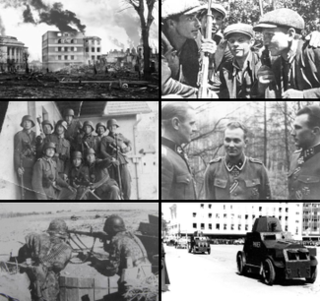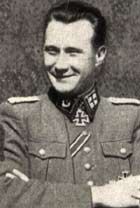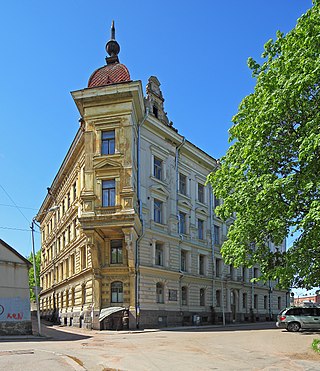
The Battle of Narva Bridgehead was the campaign that stalled the Soviet Estonian operation in the surroundings of the town of Narva for six months. It was the first phase of the Battle of Narva campaign fought at the Eastern Front during World War II, the second phase being the Battle of Tannenberg Line.

The Battle of Narva was a World War II military campaign, lasting from 2 February to 10 August 1944, in which the German Army Detachment "Narwa" and the Soviet Leningrad Front fought for possession of the strategically important Narva Isthmus.

The Battle of Tannenberg Line or the Battle of the Blue Hills was a military engagement between the German Army Detachment Narwa and the Soviet Leningrad Front. They fought for the strategically important Narva Isthmus from 25 July–10 August 1944. The battle was fought on the Eastern Front during World War II. The strategic aim of the Soviet Estonian Operation was to reoccupy Estonia as a favorable base for the invasions of Finland and East Prussia. Waffen-SS forces included 24 volunteer infantry battalions from the SS Division Nordland, the SS Division Langemarck, the SS Division Nederland, and the Walloon Legion. Roughly half of the infantry consisted of the personnel of the 20th Waffen Grenadier Division of the SS. The German force of 22,250 men held off 136,830 Soviet troops. As the Soviet forces were constantly reinforced, their overall casualties are estimated by Estonian historian Mart Laar to be 170,000 dead and wounded.

The 20th Waffen Grenadier Division of the SS was a foreign infantry division of the Waffen-SS that served alongside the Wehrmacht during World War II. According to some sources, the division was under Reichsführer-SS Heinrich Himmler's overall command but was not an integral part of the Schutzstaffel (SS). It was officially activated on 24 January 1944, and many of its soldiers had been members of the Estonian Legion and/or the 3rd Estonian SS Volunteer Brigade, which had been fighting as part of German forces since August 1942 and October 1943 respectively. Both of the preceding formations drew their personnel from German-occupied Estonia. Shortly after its official activation, widespread conscription within Estonia was announced by the German occupying authorities. The division was formed in Estonia around a cadre comprising the 3rd Estonian SS Volunteer Brigade, and was initially known as the 20th Estonian SS Volunteer Division. By 1944, a total of 60.000 Estonians were fighting in the ranks of the SS and Wehrmacht.

Estonia declared neutrality at the outbreak of World War II (1939–1945), but the country was repeatedly contested, invaded and occupied, first by the Soviet Union in 1940, then by Nazi Germany in 1941, and ultimately reinvaded and reoccupied in 1944 by the Soviet Union.

Harald Riipalu was an Estonian commander in the German Wehrmacht and the Waffen-SS during World War II. He was a recipient of the Knight's Cross of the Iron Cross of Nazi Germany.
The 6th Rifle Division was an infantry division of the Soviet Union's Red Army. Formed multiple times, it participated in several battles, most notably the Soviet westward offensive of 1918–1919, the Estonian War of Independence and the Polish–Soviet War.The division's first formation was awarded the Order of the Red Banner twice and the Order of Suvorov 2nd class for its valor in combat. In November 1945, the division was disbanded. It was briefly reformed in 1955 but disbanded again in 1957.
The Tallinn offensive was a strategic offensive by the Red Army's 2nd Shock and 8th armies and the Baltic Fleet against the German Army Detachment Narwa and Estonian units in mainland Estonia on the Eastern Front of World War II on 17–26 September 1944. Its German counterpart was the abandonment of the Estonian territory in a retreat codenamed Operation Aster.

The 8th Estonian Rifle Corps was a formation in the Red Army, created on 6 November 1942, during World War II.

The Tartu offensive operation, also known as the Battle of Tartu and the Battle of Emajõgi was a campaign fought over southeastern Estonia in 1944. It took place on the Eastern Front during World War II between the Soviet 3rd Baltic Front and parts of the German Army Group North.

This is a sub-article to Leningrad–Novgorod Offensive and Battle of Narva.

This is a sub-article to Battle of Narva (1944).

The Narva offensive was an operation conducted by the Soviet Leningrad Front. It was aimed at the conquest of the Narva Isthmus from the German army detachment "Narwa". At the time of the operation, Joseph Stalin, the supreme commander of the Soviet Armed Forces, was personally interested in taking Estonia, viewing it as a precondition to forcing Finland out of the war.

This is a sub-article to Battle of Narva.

This is a sub-article to Battle of Narva (1944).
The 1st Division was one of the three Estonian divisions created during the Estonian War of Independence, which was active until the Soviet occupation of Estonia.

The 30th Guards Leningrad Army Corps was an army corps of the Soviet Ground Forces. As part of the Red Army during the Great Patriotic War it was designated the 30th Guards Rifle Corps.
This is the order of battle for the Leningrad Strategic Defensive covering the period 10 July to 30 September 1941.
The 120th Rifle Division was an infantry division of the Red Army, formed three times. Its first formation became the 6th Guards Rifle Division for its actions in the Yelnya Offensive. Its second formation became the 69th Guards Rifle Division for its actions in the Battle of Stalingrad. The division was reformed a third time in late April 1943. It was disbanded "in place" with the Central Group of Forces in the summer of 1945.
The 64th Guards Rifle Division was created on January 19, 1943, from the 327th Rifle Division, in recognition of that division's distinguished combat record in the Second Siniavino Offensive and Operation Iskra. It was one of a relatively small number of formations raised to Guards status in the northern sector of the Soviet-German Front. As such, it was employed as an assault division in the subsequent fighting, particularly in the final defeat of the German forces before Leningrad, and the final offensive against Finland. The division ended the war in Lithuania, helping to contain the enemy forces trapped in the Courland Pocket, and went on to serve well into the postwar era, still in the Leningrad/St. Petersburg area.











